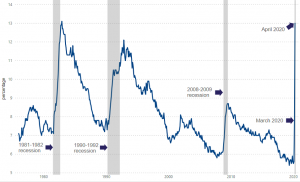Future Shock: Unemployment and COVID-19
While Canada’s lockdown-induced unemployment numbers for April were widely expected to be a shock, seeing them in black and white was still stunning. As governments in Canada and around the world invest in mitigating the economic and social impacts of the pandemic, former Parliamentary Budget Officer and current head of the Institute for Fiscal Studies and Democracy Kevin Page explains why this unemployment crisis may be different.
Kevin Page
May 10, 2020
The numbers of the April Labour Force Survey by Statistics Canada were both shocking and expected. The problem of high unemployment looms large. Not all jobs displaced by COVID-19 should be expected to return quickly as the economy re-opens. The law of unintended consequences will extract a pound of flesh. I wish this were not the case.
The April numbers were shocking for the sheer magnitude of unprecedented change. Nearly 2 million jobs — 1, 993, 800 in one month, after nearly one million lost in March. Over two months, the official unemployment rate rose 7.4 percentage points to 13 percent (an increase in unemployment of 1.3 million people; about the size of Ottawa). Add an additional 1.1 million people who were recently unemployed but left the labour force because there was little reason to look for work, you get the population of Greater Vancouver and the unemployment rate rises to 17.8 percent. In April, more than one-third of the potential labour force did not work or worked less than half their normal hours. This is an economic hit with lots of human pain.
The April numbers were expected because of the widely accepted need and support for containment policies to limit the spread of the COVID-19 coronavirus and save lives. You can’t lock down the economy without locking out workers.
Policy makers are aware of the costs of unemployment. We saw significant increases in unemployment, although not as large, after recessions in the early 1980s and 1990s, and the global financial crisis in 2008. There are financial and non-financial costs to individuals, societies and countries.
You can have a real debate about whether the financial costs of unemployment are worse than the immediate social costs (anxiety, depression, unhealthy behaviour), but they all end up as pocketbook issues, and the emotional scars that can last a lifetime.
As a kid growing up in Thunder Bay in the 1960s and 70s, I can still remember the impact on families of layoffs at the mills, manufacturing plants and grain elevators. The longer the layoffs, the deeper the personal scars and the more some skills will suffer. Since February, the number of people living in families where no one was employed increased by 24 percent (1.7 million people). That is a scary number.
You can argue that this time is different. Should not most of these layoffs be temporary? Peter Drucker, the late U.S. management expert, reminded us that “erroneous assumptions can be disastrous”.
Some sectors, like wholesale and retail trade, accommodation and food services may be slow to come back without widespread testing and tracing, or better still, a game-changing treatment or vaccine. Many of these jobs are occupied by people who work on a temporary basis with less than average wages.
Of the more than 5 million workers in the April survey who did not work but who could reasonably be expected to work when the public health crisis is over and the economy recovers, Statistics Canada indicates that approximately one-third (2 million) had no connection to a current or recent job. Many of these workers are young adults – the future of the Canadian economy. About 40 percent of the workers who were employed but worked less than half of their usual hours were concerned that they might lose their job or main source of self-employment income. The stakes and uncertainties are high.
The potential for sustained unemployment duration is a major concern for policy makers. The long term social and economic costs are particularly high. After the 2008 financial crisis, the average number of weeks of unemployment went from 15 to 22 weeks. It took 10 years of growth to get the duration down to pre-financial crisis levels. We may have a difficult time ahead.
Karl Popper, the famous philosopher of science said “all life is problem solving”. High unemployment is a major problem. As governments around the world grapple with a dangerous and highly transmissible virus with a combination of public health containment strategies and fiscal supports, they must be mindful that an economic recovery package will be needed to kickstart the economy and get back on the path towards full employment.
Contributing Writer Kevin Page, Canada’s first Parliamentary Budget Officer, is President and CEO of the Institute for Fiscal Studies and Democracy at University of Ottawa.

